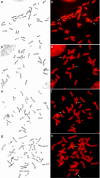Construction of a 7-fold BAC library and cytogenetic mapping of 10 genes in the giant panda (Ailuropoda melanoleuca)
- PMID: 17109760
- PMCID: PMC1664575
- DOI: 10.1186/1471-2164-7-294
Construction of a 7-fold BAC library and cytogenetic mapping of 10 genes in the giant panda (Ailuropoda melanoleuca)
Abstract
Background: The giant panda, one of the most primitive carnivores, is an endangered animal. Although it has been the subject of many interesting studies during recent years, little is known about its genome. In order to promote research on this genome, a bacterial artificial chromosome (BAC) library of the giant panda was constructed in this study.
Results: This BAC library contains 198,844 clones with an average insert size of 108 kb, which represents approximately seven equivalents of the giant panda haploid genome. Screening the library with 15 genes and 8 microsatellite markers demonstrates that it is representative and has good genome coverage. Furthermore, ten BAC clones harbouring AGXT, GHR, FSHR, IRBP, SOX14, TTR, BDNF, NT-4, LH and ZFX1 were mapped to 8 pairs of giant panda chromosomes by fluorescence in situ hybridization (FISH).
Conclusion: This is the first large-insert genomic DNA library for the giant panda, and will contribute to understanding this endangered species in the areas of genome sequencing, physical mapping, gene cloning and comparative genomic studies. We also identified the physical locations of ten genes on their relative chromosomes by FISH, providing a preliminary framework for further development of a high resolution cytogenetic map of the giant panda.
Figures



Similar articles
-
Giant panda BAC library construction and assembly of a 650-kb contig spanning major histocompatibility complex class II region.BMC Genomics. 2007 Sep 8;8:315. doi: 10.1186/1471-2164-8-315. BMC Genomics. 2007. PMID: 17825108 Free PMC article.
-
Construction, characterization and FISH mapping of a bacterial artificial chromosome library of Chinese pangolin (Manis pentadactyla).Cytogenet Genome Res. 2008;122(1):55-60. doi: 10.1159/000151316. Epub 2008 Oct 14. Cytogenet Genome Res. 2008. PMID: 18931486
-
Sequencing, annotation and comparative analysis of nine BACs of giant panda (Ailuropoda melanoleuca).Sci China Life Sci. 2010 Jan;53(1):107-111. doi: 10.1007/s11427-010-0001-z. Epub 2010 Feb 12. Sci China Life Sci. 2010. PMID: 20596962
-
Comprehensive Breeding Techniques for the Giant Panda.Adv Exp Med Biol. 2019;1200:275-308. doi: 10.1007/978-3-030-23633-5_10. Adv Exp Med Biol. 2019. PMID: 31471801 Review.
-
Progress on miRNA in giant panda (Ailuropoda melanoleuca).Yi Chuan. 2021 Sep 20;43(9):849-857. doi: 10.16288/j.yczz.21-209. Yi Chuan. 2021. PMID: 34702698 Review.
Cited by
-
Construction and preliminary characterization analysis of Wuzhishan miniature pig bacterial artificial chromosome library with approximately 8-fold genome equivalent coverage.Biomed Res Int. 2013;2013:587493. doi: 10.1155/2013/587493. Epub 2013 Apr 18. Biomed Res Int. 2013. PMID: 23691508 Free PMC article.
-
Giant panda BAC library construction and assembly of a 650-kb contig spanning major histocompatibility complex class II region.BMC Genomics. 2007 Sep 8;8:315. doi: 10.1186/1471-2164-8-315. BMC Genomics. 2007. PMID: 17825108 Free PMC article.
-
Construction of a BAC library and mapping BAC clones to the linkage map of Barramundi, Lates calcarifer.BMC Genomics. 2008 Mar 25;9:139. doi: 10.1186/1471-2164-9-139. BMC Genomics. 2008. PMID: 18366732 Free PMC article.
-
Construction and analysis of Siberian tiger bacterial artificial chromosome library with approximately 6.5-fold genome equivalent coverage.Int J Mol Sci. 2014 Mar 7;15(3):4189-200. doi: 10.3390/ijms15034189. Int J Mol Sci. 2014. PMID: 24608928 Free PMC article.
References
-
- World Wildlife Fund http://www.worldwildlife.org/pandas/
-
- Kleiman DG. Ethology and reproduction of captive giant pandas (Ailuropoda melanoleuca) Z Tierpsychol. 1983;62:1–46.
Publication types
MeSH terms
LinkOut - more resources
Full Text Sources
Research Materials
Miscellaneous

